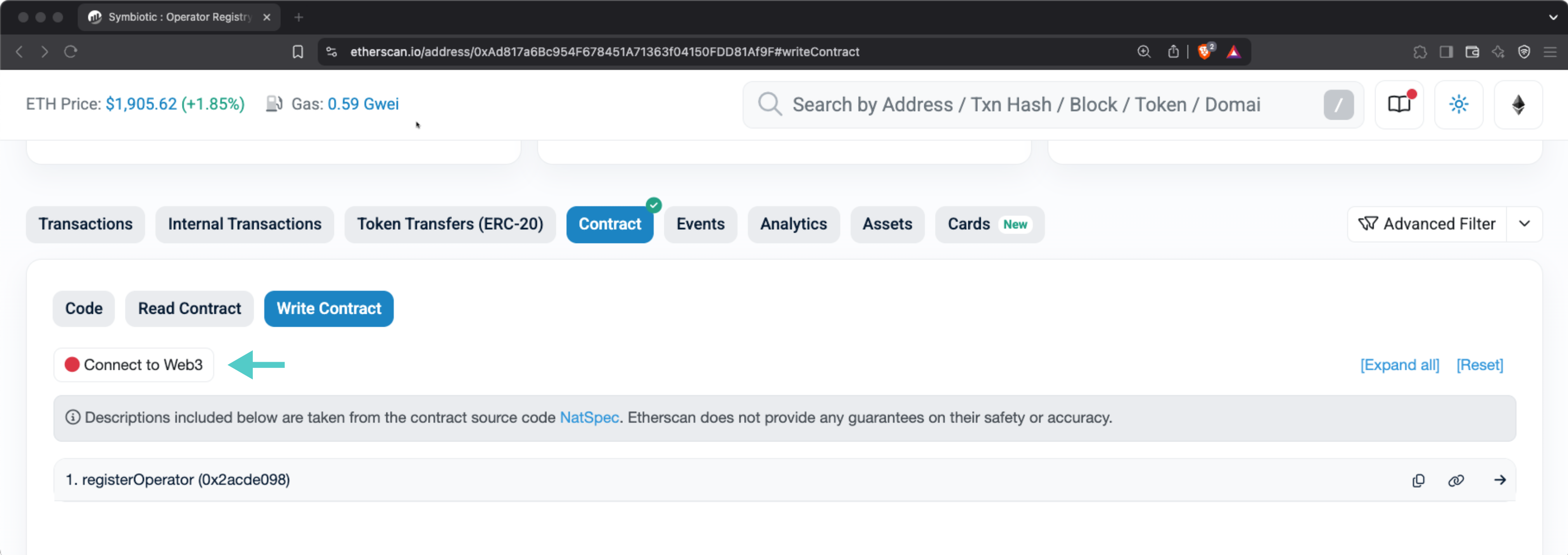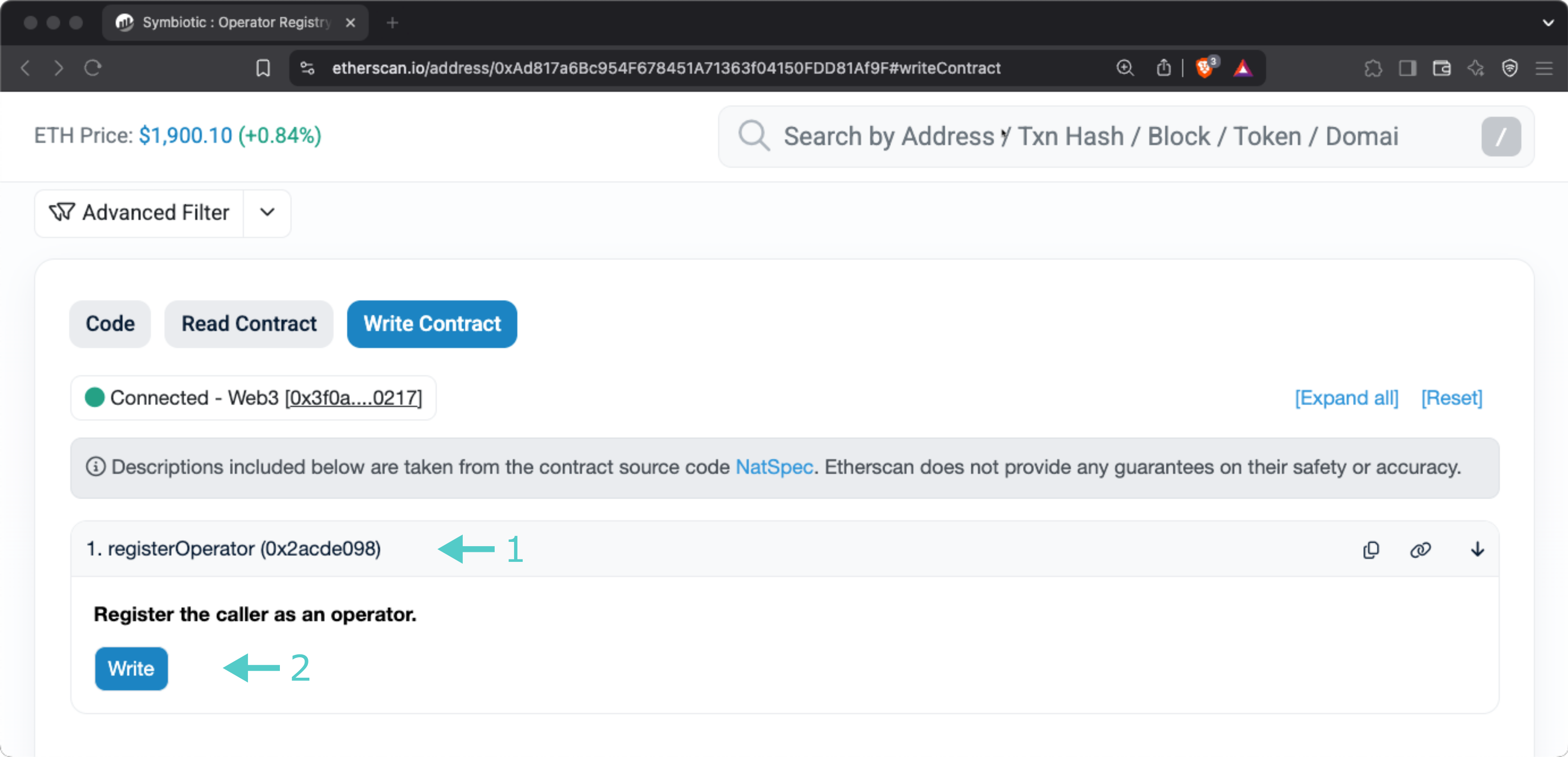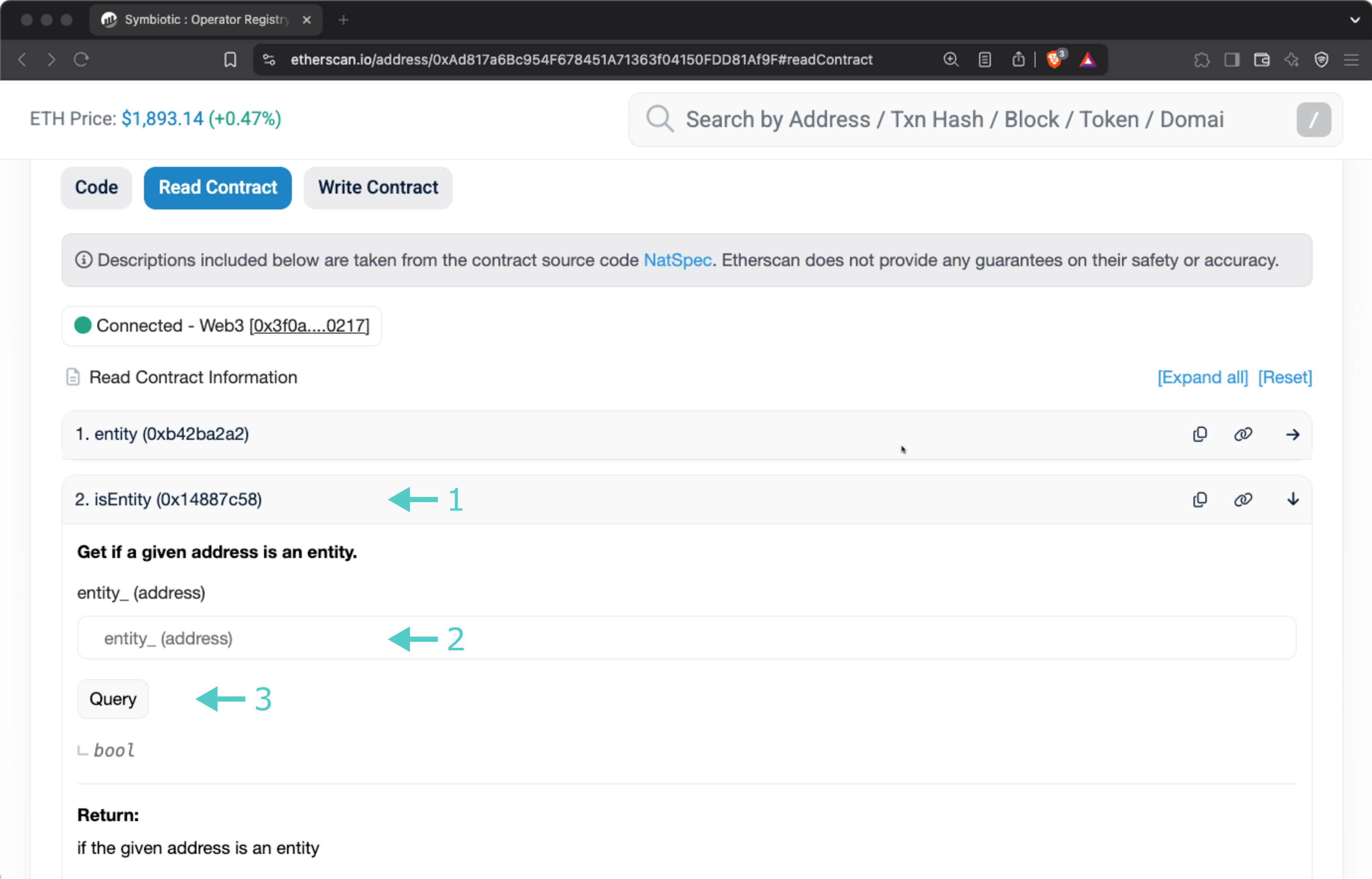Register in Symbiotic¶
Introduction¶
As presented in the onboarding section, registering in Symbiotic is the second step of the process. You should already have the node synced and running, whether using Docker or Systemd.
The Tanssi protocol provides its appchains with Ethereum-grade security from the start by relying on external security providers, such as Symbiotic. To participate as an operator in the Tanssi ecosystem, you must first register your node in the Symbiotic protocol. The registration process establishes your node as a recognized operator.
This guide will walk you through the steps to successfully register your node as a Symbiotic operator, allowing you to choose between multiple methods, including using the Symbiotic CLI, interacting directly with smart contracts through Etherscan, or utilizing Safe for multisig configurations.
Checking Prerequisites¶
Before registering as an operator, ensure you have already set up the node and it is running.
To follow this guide, you must interact with smart contracts. There are several ways to interact with the smart contracts:
- Using the Symbiotic CLI
- Using Etherscan
- Using Safe for multisig setups
In any case, you'll need to sign the transaction using the account you intend to use for the node. You can choose between different options to do so:
- Using the account's private key directly (although this method is not recommended)
- Using a hot wallet, such as MetaMask
- Using a cold wallet, such as Ledger
The following section outlines the steps for installing the Symbiotic CLI, if that's your method of preference.
Set Up the Symbiotic CLI¶
The Symbiotic CLI is a tool for interacting with Symbiotic's core smart contracts. It is written in Python, so you'll need to install the Python interpreter and pip, Python's package installer:
sudo apt-get install python3 && \
sudo apt install python3-pip
brew install python3
Now, with Python installed, download the Symbiotic CLI and its dependencies:
git clone https://github.com/symbioticfi/cli.git && \
cd cli && \
pip3 install -r requirements.txt
Run the following command to check if the installation was successful:
python3 symb.py --help
The terminal should show a long list of the CLI available commands:
Options: --chain CHAIN Chain ID to use. [default: mainnet] --provider TEXT Ethereum provider URL [http(s)]. --help Show this message and exit.
Commands: active-balance-of Get an active balance of a given account... check-opt-in-network Check if operator is opted in to a network. check-opt-in-vault Check if operator is opted in to a vault. claim Claim a withdrawal for some epoch at the... deposit Deposit to the vault. ....... ..........
Register as an Operator¶
The Symbiotic protocol keeps a registry of all operators. Before being able to secure Tanssi-powered networks, node operators must register as operators in the Symbiotic protocol using one of the methods described in the following sections.
Register Using the Symbiotic CLI¶
If you correctly installed the Symbiotic CLI and you want to sign the transaction using a Ledger device, then run the following command, replacing INSERT_OPERATOR_ADDRESS with your account:
python3 symb.py register-operator --ledger --ledger-account INSERT_OPERATOR_ADDRESS
python3 symb.py --chain sepolia register-operator --ledger --ledger-account INSERT_OPERATOR_ADDRESS
If you want to sign the transaction directly using the account private key, then run the following command, replacing the INSERT_PRIVATE_KEY parameter:
python3 symb.py register-operator --private-key INSERT_PRIVATE_KEY
python3 symb.py --chain sepolia register-operator --private-key INSERT_PRIVATE_KEY
Warning
Note that this method requires you to expose your private key; therefore, it is not recommended.
Register Using Etherscan¶
You can interact with Symbiotic's smart contracts using Etherscan and sign the transaction using a browser wallet (MetaMask, for example).
Go to the contract's page by opening the link:
Click on Connect to Web3, and select your preferred wallet (e.g. MetaMask):
Note
You can configure MetaMask to use a cold wallet.
Once connected:
- Expand the
registerOperatorfunction - Click on Write, and sign the transaction
Register Using Safe for Multisig Setups¶
If you have a Safe account, then open the Transaction builder and insert the following contract address:
0xAd817a6Bc954F678451A71363f04150FDD81Af9F
0x6F75a4ffF97326A00e52662d82EA4FdE86a2C548
Finally, pick the registerOperator function and sign the transaction.
Check the Registration Status¶
You can quickly check your registration status on Etherscan. Open the following link:
On the contract's page:
- Select the
isEntityfunction - Paste your operator's account
- Click on Query
If your operator was registered correctly, you'll get a true result, and otherwise, false
You can also verify your registration status using the Symbiotic CLI running the following command, which prints true or false for any given operator address:
python3 symb.py isop INSERT_OPERATOR_ADDRESS
python3 symb.py --chain sepolia isop INSERT_OPERATOR_ADDRESS
And the output looks like:
Submit Metadata¶
Once your operator is successfully registered, you can add metadata (e.g., logo) to improve its visibility on the Symbiotic website.
To submit your operator's metadata, head to the Symbiotic metadata repository:
Create a fork of this repo and, within the operators directory, create a new directory named after your operator's address. Within your operator's directory, add your logo.png and a file named info.json with the following fields, replacing the values with your own:
{
"name": "INSERT_YOUR_OPERATOR_NAME",
"description": "INSERT_YOUR_OPERATOR_DESCRIPTION",
"tags": [
"operator"
],
"links": [
{
"type": "website",
"name": "Website",
"url": "https://INSERT_YOUR_WEBSITE_URL"
},
{
"type": "website",
"name": "X",
"url": "https://INSERT_YOUR_X_URL"
}
]
}
Note
The links parameter is an array. Add as many links as you need.
Finally, open a pull request. The Symbiotic team will review it and merge it.
| Created: February 28, 2025


